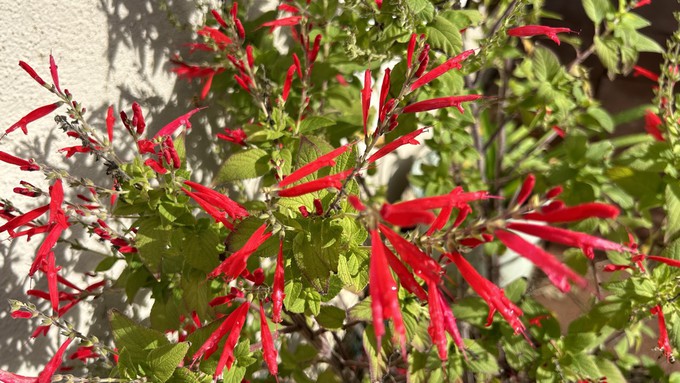
Food, flowers and shelter especially needed in winter

Pineapple sage produces gorgeous bright red tubular flowers much favored by hummingbirds. This plant grows next to a south-facing wall and is thriving even in winter. Kathy Morrison
The overwintering birds are back in my garden. The dark-eyed juncos and the white-crowned sparrows scritch in the mulch. The hummingbirds pause ever so briefly to sip nectar from the still-blooming pineapple sage. The lesser goldfinches flit into branches of the crape myrtle, checking the scene before they snack at the bird feeder, then take a quick drink from the birdbath.
Then one of the local jays arrives, landing like a jumbo jet and scaring them all off -- for a few minutes, at least.
It's easy to make even a small yard inviting for the local birds, who during winter might need some help staying safe and staying fed. Many trees have lost their leaves, and along with it the cover they provide. The usual food is gone, too: Most insects are dormant, and the caterpillars are gone until warmer weather.
So the birds seem to appreciate the shrubs, the leaf-scattered planting beds, the tubular flowers and the human-provided seeds, nuts and water.
Here are some suggestions for plants that support birds, especially in winter (and often pollinators and other wildlife during the rest of the year). Among them are native-plant recommendations from the National Audubon Society. Follow the links here to read more about the plants.
-- Blue elderberry, Sambucus mexicana. Elderberries provide a crucial source of food for birds in California; the blue variety is native to the Sacramento region.
-- Coffeeberry, Frangula california. The plant has small white flowers in summer that later turn into dark berries popular with birds.
-- Common manzanita, Arctostaphylos manzanita. Hummingbirds are attracted to the flowers, while other birds go for the fruits.
-- Common snowberry, Symphoricarpos albus. Attractive white berries give this native its common name.
-- Coyote bush (aka coyote brush), Baccharis pilularis. Lesser goldfinches are fond of the seeds.
-- Interior live oak, Quercus wislizeni. and scrub oak, Quercus berberidifolia. Native oaks are the "keystone" species for native wildlife, and they are also one of the easiest to grow. (Just ask the squirrels, who plant them regularly.) The acorns provide food, and the tree provides shelter.
-- Toyon, Heteromeles arbutifolia. The red berries are popular with mockingbirds, among others.
Unofficially, I've found that not only do the hummingbirds like the pineapple sage (Salvia elegans), they also frequently visit the red and white flowers of the "Hot Lips" salvia (Salvia microphylla). The lesser goldfinches have found the two frost-killed basil plants that I never pulled out, and they're enjoying the seeds that remain there. None of these is native, but they do add plant diversity to the garden and to the birds' food sources.
If you're intrigued by this topic, you should know that "habitat gardening" is the theme of the 2024 Sacramento Master Gardeners' Gardening Guide & Calendar, still available through the website here. (It will also be on sale at in-person winter events such as the Jan. 20 Open Garden at the Fair Oaks Horticulture Center.) The publication is packed with valuable information on supporting wildlife through plantings.
My 2022 post on becoming a birdwatcher can be found here.
Comments
0 comments have been posted.Sacramento Digs Gardening to your inbox.
Sites We Like
Garden Checklist for week of May 12
Get your gardening chores and irrigation done early in the day before temperatures rise.
* Plant, plant, plant! It’s prime planting season in the Sacramento area. Time to set out those tomato transplants along with peppers and eggplants. Pinch off any flowers on new transplants to make them concentrate on establishing roots instead of setting premature fruit.
* Direct-seed melons, cucumbers, summer squash, corn, radishes, pumpkins and annual herbs such as basil.
* Harvest cabbage, lettuce, peas and green onions. This heat will cause leafy greens and onions to flower; pick them before they bolt.
* In the flower garden, direct-seed sunflowers, cosmos, salvia, zinnias, marigolds, celosia and asters.
* Plant dahlia tubers. Other perennials to set out include verbena, coreopsis, coneflower and astilbe.
* Transplant petunias, marigolds and perennial flowers such as astilbe, columbine, coneflowers, coreopsis, dahlias, rudbeckia and verbena.
* Keep an eye out for slugs, snails, earwigs and aphids that want to dine on tender new growth.
* Feed summer bloomers with a balanced fertilizer.
* For continued bloom, cut off spent flowers on roses as well as other flowering plants.
* Got fruit trees? If you haven't already done so, thin orchard fruit such as apples, peaches, pears, pluots and plums before they grow too heavy, breaking branches or even splitting the tree. Leave the largest fruit on the branch, culling the smaller ones, and allow for 5 to 6 inches (or a hand's worth) between each fruit.
* Thin grape bunches, again leaving about 6 inches between them. For the remaining bunches, prune off the "tail" end, about the bottom third of the bunch, so that the plant's energy is concentrated in the fruit closest to the branch.
* As spring-flowering shrubs finish blooming, give them a little pruning to shape them, removing old and dead wood. Lightly trim azaleas, fuchsias and marguerites for bushier plants.
* Add mulch to the garden to help keep that precious water from evaporating. Mulch also cuts down on weeds. But don’t let it mound around the stems or trunks of trees or shrubs. Leave about a 6-inch to 1-foot circle to avoid crown rot or other problems.